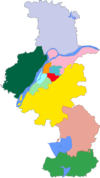Qixia Temple
32°09′15″N 118°57′14″E / 32.15417°N 118.95389°E

Qixia Temple (Chinese: 栖霞寺; pinyin: Qīxiá Sì) is a Buddhist temple located on Qixia Hill in the suburban Qixia District of Nanjing, Jiangsu Province, People's Republic of China, 22 kilometres (14 mi) northeast of downtown Nanjing. It is one of Nanjing's most important Buddhist temples.
Built in AD 489, the 7th year of the Yongming (永明) era during the South Qi Dynasty,[1] the temple is known for its large collection of Chinese Buddhist visual art and sculptural art in the grounds. These consist of pagodas, murals and artwork that date back to the 10th century.[1]
Near the temple site and situated on the slopes of Qixia Hill, there lie the "Thousand Buddha Caves", a grottoe containing many Buddhist sculptural works of art.[1]
Description
Buddha's Relics Pagoda at Qixia Temple
The Buddha's Relics Pagoda is located in the southeast of Qixia Temple. It was built in 601 and destroyed in the Tang Dynasty. Then in 945, it was rebuilt by Southern Tang Dynasty emperor Li Jing. The pagoda has a 5-story, octagon-shaped structure. It is 18m high and perched on a 2-story stylobate carved with waves and a dash of fish and Chinese flowering crabapples.
Gallery
References
- ^ a b c Qixia Temple





